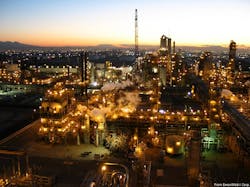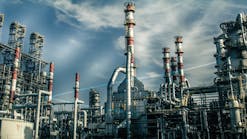California regulators approve restart of ExxonMobil’s Torrance refinery
California’s South Coast Air Quality Management District’s (SCAQMD) has approved an order that will allow ExxonMobil Corp. to restart the fluid catalytic cracker (FCC) at its 155,000-b/d refinery at Torrance, Calif., which has been shuttered since an explosion and ensuing fire struck the unit in February 2015 (OGJ Online, Feb. 19, 2015).
In a vote of 3-2, SCAQMD’s hearing board adopted an order for abatement consenting to the restart of the FCC and associated equipment—including the electrostatic precipitator (ESP), an air pollution-control device destroyed in the explosion—at a public hearing held on Apr. 2, SCAQMD said.
Under the jointly negotiated order, which remains valid until July 29, ExxonMobil has agreed to comply with a series of conditions before it begins the restart process, the state regulator said.
Alongside a requirement to pay $5 million in penalties for air-pollution violations resulting both from the 2015 incident as well as anticipated violations as determined by SCAQMD that could occur during the restart process, ExxonMobil also must:
• Follow a specific start-up sequence designed to minimize excess emissions and ensure a safe restart.
• Mitigate excess emissions through steps that include but are not limited to reducing overall refinery throughput by about 25% to 100,000 b/d during startup; shutting down two coker heaters; and operating all drift eliminator upgrades to the pretreater, hydrotreater, fuel gas treater, and north and south coker cooling towers.
• Provide public advance notice of at least 48 hr that the ESP—which controls fine particulate emissions from the FCC—is not in use.
• Retire emission credits for excess nitrogen oxide emissions for a period of 12 hr during startup.
• Report all visible emissions or odor complaints from the public to the SCAQMD within 30 min of occurring.
Because SCAQMD estimates that the FCC’s restart will result in higher emissions of particulate matter for about 6 hr longer than permissible under SCAQMD rules and the refinery’s Title V permit, the order additionally stipulates that these 6 hr cannot occur during school and business hours.
ExxonMobil also will be required to mitigate excess emissions to the maximum extent feasible during startup operations by taking steps to reduce emissions in other areas of the refinery, SCAQMD said.
“This approved order adopted by SCAQMD’s hearing board puts in place stringent measures designed to protect the health and safety of nearby residents while the refinery resumes normal operations,” said Kurt Wiese, general counsel for the SCAQMD, adding that a substantial portion of ExxonMobil’s penalty fines will be used to benefit surrounding communities.
The order follows a series of investments by ExxonMobil to execute repairs and upgrades at Torrance, which has operated at about 20% of its rated capacity since the February explosion.
To date, the company has spent about $161 million to repair damaged ESPs, as well as an additional $1.1 million on drift eliminator upgrades to the refinery’s pretreater, hydrotreater, fuel-gas treater, and north and south coker cooling towers, according to SCAQMD documents.
ExxonMobil has yet to disclose a precise timeframe for when it will begin restarting units at Torrance covered by the order.
Refinery disposition
The pending restoration of the Torrance refinery to full-working order following damages from the February fire is a prerequisite to a deal ExxonMobil made in late 2015 for the sale of the refinery and related assets to PBF Holding Co. LLC, a subsidiary of PBF Energy Inc., Parsippany, NJ (OGJ Online, Oct. 1, 2015).
Valued at about $537.5 million, the deal—which includes the Torrance manufacturing site as well as ExxonMobil’s related California product terminals, crude and product pipelines, and other logistics assets—originally was scheduled to close sometime during this year’s second quarter.
While PBF Energy continues to look forward to closing on the Torrance acquisition this quarter, the company told investors on Feb. 29 in its annual report for 2015 that there could be assurance as to when or if it would complete the transaction.
Alongside gaining all necessary regulatory approvals and restoration of refining operations to their full-working order prior to the February 2015 explosion, the Torrance refinery also must operate for at least 15 days without incident after such restoration, according to the proposed sale agreement.
Contact Robert Brelsford at [email protected].

